INDEX
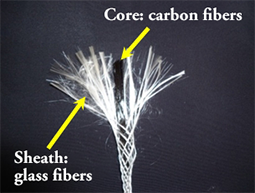
CABKOMA’s sheath-core fiber structure, which covers the carbon fiber core with a glass fiber sheath 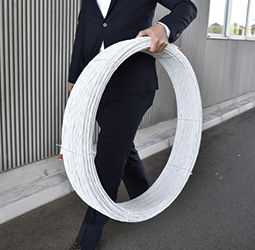
Lightweight and portable, a roll of CABKOMA 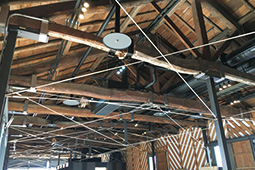
Tomioka Warehouse No.3, with CABKOMA installed as a seismic reinforcement material 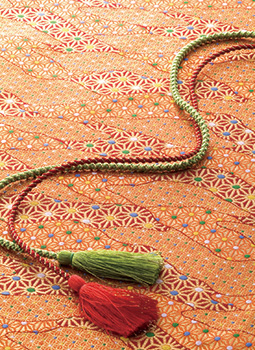
Kumihimo
September 2020
A New Rust-Free Material That Is Stronger and Lighter than Steel
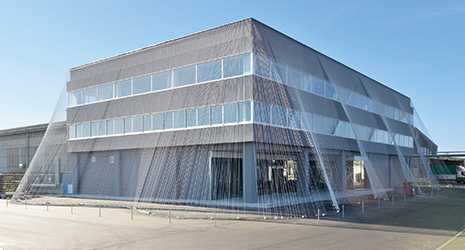
A textile company in Ishikawa Prefecture has developed a carbon fiber composite material, a new material stronger than steel, by applying a traditional Japanese braiding technique known as kumihimo. This new material is gaining attention as a new one for seismic reinforcement, being one-fifth as light as steel and extremely strong.
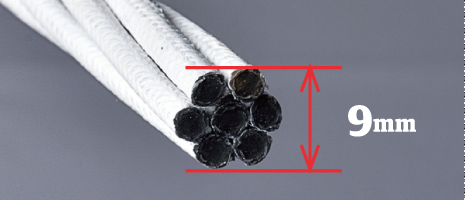
Kumihimo is a traditional braiding technique in Japan with more than 1,000 years of history. Ordinary textiles are made by crossing the warp and the weft (weaving). Kumihimo, in contrast, is a technique where several threads or several dozen threads of silk or other fibers are clustered together as one, and, gathering three or more of these clusters, a braid is created by crossing them diagonally, front to back, or top to bottom. The shape of the braids is often likened to girls’ pigtail hair with three or four braids. It is difficult to make a large, flat, textile-like object with this technique, but it is suitable for making cord-like objects. In Japan, it is said that this technique was brought over from mainland China in ancient times and the technique was developed in the Heian period (from 794 until around the end of the twelfth century), mainly being used for small decorative parts of kimono and later being used as decorations for weapons and more, which continues to the present day. Even today, it is common to attach a kumihimo braid on top of the obi sash as decoration (the obijime) when wearing kimono in Japan.
CABKOMA Strand Rod (CABKOMA, for short), a carbon fiber composite material in wire form developed by Komatsu Matere Co., Ltd, a textile company in Ishikawa Prefecture, uses the kumihimo technique in the manufacturing of wires for buildings.

Okuya Teruhiro, Director of the Research and Development Division at Komatsu Matere, says, “In 2008, Ishikawa Prefecture developed a policy to promote the advancement of the textile industry into fields other than clothing-related fields to promote the development of textiles, which is the most important industry in the prefecture. In response, our company moved forward with the development of new wires that could be used in the field of architecture, utilizing textile techniques. Conventional wires used as construction materials were heavy, and the handling and transportation costs had become an issue, so we thought there was great need for a lightweight, flexible product that withstood time-related deterioration. We decided to make use of the traditional kumihimo technique in developing a product.”
To make CABKOMA, seven strands of carbon fiber are each wrapped in a sheath of multiple glass fibers in the braided manner of kumihimo then twisted together and soaked in resin to form a wire.
Its biggest features are that it is lightweight, strong and rust-free. With a weight one-fifth the weight of steel and approximately ten times the strength, it also has superior heat and chemical resistance.

Ordinary carbon fiber has strong elasticity, but is weak to parallel force. CABKOMA, however, is strong and flexible due to the glass fibers covering the carbon fiber core being braided like kumihimo. It has a diameter of 9 mm, but even an approximately 160-meter-long strand weighs only 12 kg, and can be carried by hand. It is just one-fifth the weight of conventional metal wire but with the same level of strength.
This CABKOMA is currently gaining attention especially as a material for seismic resistance in earthquake-prone Japan.
In 2015, Komatsu Matere used CABKOMA as a material for seismic resistance for renovations of their headquarters at the time. CABKOMA was not only attached like bracing on the interior of the building, but it also connected the roof of the building with the ground on the exterior. Dr. Kuma Kengo, a world-famous architect, worked on the cutting-edge design that stretches and wraps approximately 1,000 CABKOMA cables around the entire building. Dr. Kuma, who after the Great East Japan Earthquake thought that the time had come where buildings would be built with flexible materials, praised CABKOMA, as it combines flexibility with strength.

Later, after gaining experience in seismic retrofits at the Zenkoji Temple Scripture House in Nagano Prefecture and the former Tomioka Silk Mill in Gunma Prefecture, CABKOMA was certified as a Japanese Industrial Standards (JIS) standard for a material for seismic resistance in 2019 – the first such certification for a carbon fiber composite material.
Okuya comments, “It is said that there are several million wooden homes that do not meet earthquake resistance standards in Japan, and more and more of these homes urgently need seismic reinforcement. I want to contribute to this field first. In the future, we hope CABKOMA can be used in the same way as steel is used in steel-reinforced concrete. The deterioration of steel-reinforced concrete begins with the steel inside the concrete rusting. If CABKOMA is used in place of steel, it will be possible to expand the current 50-year lifespan of steel-reinforced concrete to over 100 years. I would be happy if we could contribute to the longevity of buildings around the world with this technology.”


